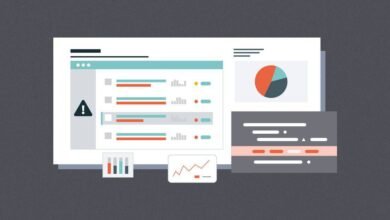Top 3 Reports to Help You Run a Better Business

Do you know Top 3 Reports to Help You Run a Better Business? If you’re serious about making your business a success, it’s important to understand the data behind the operations that drive it. Sure, you could look at your bank account balance to get an idea of how the business is doing financially, but that doesn’t tell the whole story.
The truth is that running a successful business requires more than just financial smarts; it requires understanding how all of your processes are performing and how they interact. To gain this insight, you need access to high-level reports that will help you make strategic decisions about your operations.
But which reports should you access? Don’t worry—you don’t need to be a data wizard or have a degree in statistics to get this right. In this article, I’ll provide a simple breakdown of three essential reports that every business leader should use to gain deeper insights into their operations and improve their bottom line.
Read more: Business Are Mobile Technology Transforming in 2023
The Key Performance Indicators Report
If you’re a business owner, you know that performance reports are key to staying informed about the health of your business. And one of the most important reports to monitor is your Key Performance Indicators (KPIs) report.
KPIs are business metrics used to measure progress towards specific goals or objectives, and they normally fall into three categories: financial metrics, customer metrics, and operational metrics. The KPIs report pulls together data on these three areas and gives a snapshot of how your overall business is performing. This can help you identify potential problem areas before they become bigger issues down the road.
Not sure which KPIs are most important for your organization? Look at each area individually and determine which metrics best reflect the performance of that particular part of your operations. That way, when you check in on your KPIs report regularly, you’ll be able to spot any red flags quickly and take corrective action when necessary.
Customer Service Reports
Your customer service team is the face of your business—and understanding how they’re performing is key to your success as a company. That’s why customer service reports can be so useful. They provide invaluable insights into how well your team is performing, and which areas need improvement.
Customer service reports can include:
- Abandoned Call Rate (ACR): This metric measures the percentage of calls that were terminated by a customer before reaching an agent.
- Average Call Duration (ACD): This captures the average length of answered calls, providing an insight into how quickly agents are responding to customer queries.
- Average Handle Time (AHT): This measure indicates how long customers wait for an answer, including any time an agent spends on hold.
By keeping track of these metrics regularly, you’ll have a clear view into how your customer service team is performing—and if there are any areas that need attention or improvement.
Marketing Reports
If you’re looking for ways to get more value from your marketing efforts, look no further than marketing reports.
Marketing reports provide valuable insight into how your campaigns are performing and what activities are having the most impact. By keeping track of your marketing efforts, you can identify areas where you may be able to optimize campaigns or make improvements that can help drive more sales.
Examples of Reports to Monitor
When it comes to marketing reports, there are a few key metrics that you should keep an eye on:
- Traffic sources – Knowing where your visitors originate will give you insight into which channels are driving the most traffic. This information can be used to focus more on higher-performing channels and adjust campaigns accordingly.
- Conversion rates – It’s important to track how many visitors convert into leads or customers. This report will tell you which channels, campaigns, and activities are producing the best results so you know where to focus your efforts.
- Engagement – Keeping an eye on how engaged users are with your site will give you an idea of how interested they are in what you have to offer. You can use this information to tailor content and messaging accordingly.
By running regular marketing reports, you can gain a deeper understanding of how your website is performing and use those insights to help drive better results for your business.
The Financial Ratios Report
It’s not just about tracking sales and expenses—you also want to get an overall view of your business’s financial health. That’s where the Financial Ratios Report comes in. This report helps you compare key performance indicators (KPIs) to benchmarks and other data points, which helps give you a better understanding of how your business is performing compared to others in the same industry.
The KPIs this report monitors include:
- Liquidity Ratios – This measures the amount of cash that is available to pay debts when they come due.
- Activity Ratios – This measures how effectively your company is using its assets, like inventory and accounts receivables.
- Leverage Ratios – This measures whether or not a company has too much debt or not enough assets to cover it.
- Profitability Ratios – This compares income with costs and expenses, giving you an indication of how well your business is performing financially.
The Financial Ratios Report can be used to keep track of trends over time and make informed decisions about investments, borrowing money and so on. Not only will this help improve operational efficiency—it can also help you identify areas for improvement, as well as potential revenue sources that have been previously untapped.
The Balanced Scorecard Report
You already know that keeping track of your business performance is essential for success, and the Balanced Scorecard Report is one of the best ways to do just that. This report takes a systematic approach to performance tracking and helps you evaluate everything from customer satisfaction to financial performance, as well as every other aspect of your business operations. It even provides a detailed assessment of how well you are achieving corporate goals and objectives.
Put simply, it helps you keep an eye on how healthy your business is.
What’s In The Balanced Scorecard Report?
The report provides detailed insights into:
- Employee productivity
- Profitability
- Return on investment (ROI)
- Quality and customer satisfaction levels
- Productivity ratios
- Overall operational efficiency
- Market share growth rates
At its core, the Balanced Scorecard Report gives you the insight and clarity needed to make informed decisions about what strategies are working (and which ones aren’t) so you can make changes in real-time—and get the most out of your team.
Read more: Benefits of Social Media on Autopilot for Your Small Business
Analyzing Your Reports to Improve Business Performance

Analyzing your reports can be one of the most important aspects of running a successful business. Having a system in place to take a deep dive into the data is essential. You can then use this information to find areas of improvement and make changes as needed.
Here are the steps you should take to analyze your reports:
- Identify & Set Goals: Start by outlining your business goals and objectives, and then create an action plan to reach those goals. Once you have these in place, identify any key performance indicators (KPIs) that will help measure your progress against those goals.
- Assess & Measure: This is where you’ll be looking at your reports and evaluating them based on your KPIs to determine how well you’re performing against those goals. For instance, if one of your KPIs was customer satisfaction, how satisfied are customers with the current product or service? Are there any areas for improvement?
- Act & Adapt: After you’ve identified any areas for improvement from assessing and measuring, it’s time to take action and make the necessary adjustments to achieve better results. This could mean implementing new processes or changes in strategy that will help improve performance.
By analyzing your reports regularly, you’ll be able to track progress towards success, identify weaknesses or detect opportunities for growth earlier than if you left it unchecked – allowing for better business decision-making overall!
How to Use the Reports to Guide Strategy and Decision Making
Now that you know the top three reports to help you run a better business, let’s talk about ways to use them to guide your strategy and decision making.
Financial Reports
Financial reports help you assess the health of your business by looking at your balance sheet and income statement. For example, if you notice a decrease in revenue or an increase in expenses, this could be a sign that something needs to change. You can also use the financial report to make projections about future profitability and performance.
Competition Analysis
The competition analysis helps you understand what other businesses are doing in relation to yours. It’s important to keep an eye on your competitors so that you can identify areas where you can improve and stay ahead of the competition. Understanding their strategies can also help inform your decision making, allowing you to make informed decisions about pricing and product offerings.
Customer Insights
Customer insights provide valuable information about who your customers are, what they need and want, and how they interact with your business. This data helps you make decisions related to marketing, product design, customer service, market segmentation, and more. By understanding customer behavior, you can tailor your offerings accordingly so that they appeal more to potential customers and build customer loyalty among existing customers.
Benefits of Accessing Pre-Formatted Reports
Knowing the right numbers is essential to achieving success in your business. But, manually creating reports and collecting data can be time-consuming and challenging. That’s why accessing pre-formatted reports is so beneficial. Doing so can:
- Help you identify trends that can drive growth opportunities in your business.
- Enable you to pinpoint areas of improvement, allowing you to make more informed decisions when it comes to allocating resources.
- Save time by eliminating the need to manually pull together data yourself—leaving you more time for other tasks that are important for running a successful business.
Pre-formatted reports are a great way to get an overview of your business performance quickly, giving you actionable insights that will empower you to make better decisions and reach greater heights faster than ever before!
Conclusion
Knowing what to look for in business reports is essential for making well-informed decisions about the direction of your company. By having access to real-time reports, understanding financial trends, and being aware of potential risks, you will be well-positioned to make adjustments to ensure that your business continues to grow and be successful.
Having the right reports on hand will enable you to better understand the financial position of your business and what strategies would help you to effectively manage its operations. With the right reports, you will be able to make decisions with confidence and ensure that you are running a successful business.











